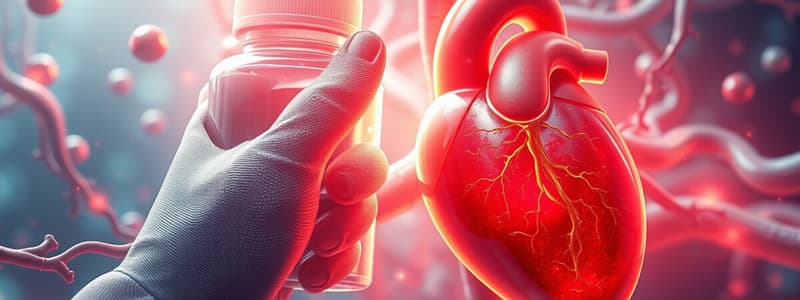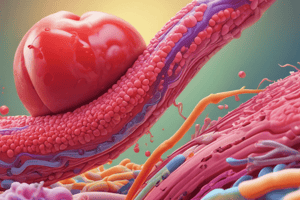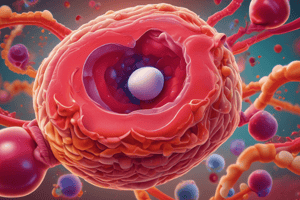Podcast
Questions and Answers
What is the primary action of HMG-CoA (Statins) in the body?
What is the primary action of HMG-CoA (Statins) in the body?
- Reduces triglyceride levels
- Increases cholesterol production
- Controls cholesterol production (correct)
- Increases HDL levels
Which of the following is NOT a side effect of HMG-CoA (Statins)?
Which of the following is NOT a side effect of HMG-CoA (Statins)?
- Myositis
- Heart palpitations (correct)
- Liver dysfunction
- Rhabdomyolysis
What is an important nursing implication when administering HMG-CoA (Statins)?
What is an important nursing implication when administering HMG-CoA (Statins)?
- Monitor for signs of constipation
- Monitor liver function tests and CK levels (correct)
- Ensure the patient is on a high-protein diet
- Assess for signs of hypertension
Which of the following statements about HMG-CoA (Statins) is true regarding patient teaching?
Which of the following statements about HMG-CoA (Statins) is true regarding patient teaching?
What dietary consideration is advised for patients taking HMG-CoA (Statins)?
What dietary consideration is advised for patients taking HMG-CoA (Statins)?
What is the primary action of inotropic drugs such as digoxin?
What is the primary action of inotropic drugs such as digoxin?
Which of the following symptoms is NOT associated with digoxin toxicity?
Which of the following symptoms is NOT associated with digoxin toxicity?
What should be monitored closely to prevent digoxin toxicity?
What should be monitored closely to prevent digoxin toxicity?
What is an important patient teaching point regarding the administration of digoxin?
What is an important patient teaching point regarding the administration of digoxin?
Which of the following drug interactions is a concern for patients taking digoxin?
Which of the following drug interactions is a concern for patients taking digoxin?
What is the action of selective cholesterol absorption inhibitors?
What is the action of selective cholesterol absorption inhibitors?
What is a common example of a fibric acid derivative?
What is a common example of a fibric acid derivative?
What is an important nursing implication for patients taking bile acid sequestrants?
What is an important nursing implication for patients taking bile acid sequestrants?
Which of the following side effects is associated with thiazide diuretics?
Which of the following side effects is associated with thiazide diuretics?
What is the main action of ACE inhibitors?
What is the main action of ACE inhibitors?
Which patient condition can be masked by beta blockers?
Which patient condition can be masked by beta blockers?
What is an action of potassium-sparing diuretics?
What is an action of potassium-sparing diuretics?
What is a common side effect of calcium channel blockers?
What is a common side effect of calcium channel blockers?
Which type of drug is primarily used to treat hypertension by reducing fluid volume?
Which type of drug is primarily used to treat hypertension by reducing fluid volume?
What should patients receiving niacin be monitored for due to potential adverse effects?
What should patients receiving niacin be monitored for due to potential adverse effects?
Which drug class prevents reabsorption of water and sodium in the nephron to treat hypertension?
Which drug class prevents reabsorption of water and sodium in the nephron to treat hypertension?
What effect do angiotensin II receptor blockers (ARBs) have on the body?
What effect do angiotensin II receptor blockers (ARBs) have on the body?
What dietary consideration should be made for patients on thiazide diuretics?
What dietary consideration should be made for patients on thiazide diuretics?
What is a primary use for Alpha 1 adrenergic antagonists?
What is a primary use for Alpha 1 adrenergic antagonists?
What is a significant side effect of Alpha 2 agonists like clonidine?
What is a significant side effect of Alpha 2 agonists like clonidine?
What should be monitored closely when a patient is on vasodilators?
What should be monitored closely when a patient is on vasodilators?
Why should a patient with chronic stable angina be given nitroglycerin sublingually during an acute attack?
Why should a patient with chronic stable angina be given nitroglycerin sublingually during an acute attack?
What is a common side effect that patients should be informed about when using nitrates?
What is a common side effect that patients should be informed about when using nitrates?
What condition is characterized as an abnormal heart rhythm due to irregularities in the cardiac conduction system?
What condition is characterized as an abnormal heart rhythm due to irregularities in the cardiac conduction system?
What class of antidysrhythmic drugs includes sodium channel blockers?
What class of antidysrhythmic drugs includes sodium channel blockers?
Why is it important to assess the apical pulse before administering an antidysrhythmic medication?
Why is it important to assess the apical pulse before administering an antidysrhythmic medication?
What should be included in patient education regarding the use of anti-hypertensive medications?
What should be included in patient education regarding the use of anti-hypertensive medications?
In patients prescribed with nitroglycerin patches, at what time frame should the patches generally be removed?
In patients prescribed with nitroglycerin patches, at what time frame should the patches generally be removed?
What is a common side effect of potassium channel blockers?
What is a common side effect of potassium channel blockers?
In managing severe hypotension that may occur with the first dose of an Alpha-1 antagonist, when should the medication ideally be administered?
In managing severe hypotension that may occur with the first dose of an Alpha-1 antagonist, when should the medication ideally be administered?
What potential danger exists when stopping Alpha 2 agonists abruptly?
What potential danger exists when stopping Alpha 2 agonists abruptly?
Which of the following adverse effects can result from the use of digoxin in antidysrhythmic treatment?
Which of the following adverse effects can result from the use of digoxin in antidysrhythmic treatment?
What is a significant adverse effect associated with HMG-CoA (Statins)?
What is a significant adverse effect associated with HMG-CoA (Statins)?
Which statement accurately reflects the use of HMG-CoA (Statins) in specific populations?
Which statement accurately reflects the use of HMG-CoA (Statins) in specific populations?
Which dietary consideration should be taken into account when taking HMG-CoA (Statins)?
Which dietary consideration should be taken into account when taking HMG-CoA (Statins)?
What is an important action to take when a patient is prescribed HMG-CoA (Statins)?
What is an important action to take when a patient is prescribed HMG-CoA (Statins)?
What should patients taking HMG-CoA (Statins) be educated about regarding grapefruit juice?
What should patients taking HMG-CoA (Statins) be educated about regarding grapefruit juice?
What is the primary action of selective cholesterol absorption inhibitors?
What is the primary action of selective cholesterol absorption inhibitors?
What adverse effect should be monitored for in patients taking fibric acid derivatives?
What adverse effect should be monitored for in patients taking fibric acid derivatives?
Which of the following is a characteristic side effect of ACE inhibitors?
Which of the following is a characteristic side effect of ACE inhibitors?
What is a common nursing implication for patients on diuretics?
What is a common nursing implication for patients on diuretics?
What is the mechanism of action for calcium channel blockers?
What is the mechanism of action for calcium channel blockers?
Which of the following side effects is most commonly associated with HMG-CoA (Statins)?
Which of the following side effects is most commonly associated with HMG-CoA (Statins)?
What is a significant risk associated with the interaction of grapefruit juice and HMG-CoA (Statins)?
What is a significant risk associated with the interaction of grapefruit juice and HMG-CoA (Statins)?
Which of the following statements is true regarding the mechanism of action of statins?
Which of the following statements is true regarding the mechanism of action of statins?
Flashcards are hidden until you start studying
Study Notes
Cardiovascular Drugs
Common Types
- Antihyperlipidemics: Lower levels of lipids in the blood.
- Antihypertensives: Manage high blood pressure to prevent organ damage.
- Drugs for Angina: Treat chest pain caused by reduced blood flow to the heart.
- Drugs for Heart Failure: Help improve heart function and circulation.
- Antidysrhythmics: Restore normal heart rhythm.
Antihyperlipidemic Drugs
-
Hyperlipidemia: Elevated levels of lipids, mainly cholesterol, in the blood.
-
HMG-CoA Reductase Inhibitors (Statins):
- Example: Atorvastatin, Simvastatin, Lovastatin, Pravastatin, Rosuvastatin.
- Action: Inhibit the liver enzyme responsible for cholesterol production.
- Uses: Reduce LDL cholesterol, lower cardiovascular risk.
- Side Effects: Liver dysfunction, pancreatitis, myositis, rhabdomyolysis.
- Considerations: Not advised during pregnancy or breastfeeding. Monitor liver function and CK levels, and avoid grapefruit juice.
-
Non-Statin Hyperlipidemic Drugs:
- Selective Cholesterol Absorption Inhibitors: Example: Ezetimibe.
- Fibric Acid Derivatives (Fibrates): Example: Gemfibrozil, Fenofibrate; lower triglycerides and raise HDL but can cause liver toxicity.
- Bile Acid Sequestrants: Example: Cholestyramine, Colestipol - promote cholesterol excretion.
- Niacin: Can inhibit hormone-sensitive lipase; less used due to adverse effects.
Antihypertensive Drugs
-
Hypertension: Chronic condition leading to potential heart, brain, or kidney damage.
-
Diuretics:
- Thiazide Diuretics: Example: Hydrochlorothiazide; prevent electrolyte reabsorption.
- Loop Diuretics: Example: Furosemide; increase urine output.
- Potassium-Sparing Diuretics: Example: Spironolactone; help maintain potassium levels.
- Side Effects: Electrolyte imbalance, dehydration, increased uric acid.
-
Renin-Angiotensin-Aldosterone System Drugs:
- ACE Inhibitors: Example: Captopril, Enalapril; prevent angiotensin I from converting to angiotensin II.
- Angiotensin II Receptor Blockers (ARBs): Example: Losartan, Valsartan; block effects of angiotensin II.
-
Calcium Channel Blockers:
- Uses: Treat chronic stable angina, hypertension, and dysrhythmias.
- Examples: Verapamil, Nifedipine, Diltiazem, Amlodipine.
- Side Effects: Dysrhythmias, fatigue, dizziness, headache, avoid grapefruit juice.
-
Adrenergic Drugs:
- Beta Blockers: Lower heart rate and blood pressure; examples include Propranolol, Metoprolol.
- Alpha Blockers: Reduce peripheral vascular resistance; examples include Doxazosin, Prazosin.
- Alpha 2 Agonists: Example: Clonidine; decrease blood pressure through CNS action.
-
Vasodilators:
- Dilate arteries and veins, lowering blood pressure.
- Examples: Hydralazine, Minoxidil; monitor for hypotension.
Angina and Myocardial Infarction Drugs
- Nitrates:
- Treat angina by dilating blood vessels and reducing heart workload.
- Example: Nitroglycerin for acute attacks; Isosorbide for management.
- Side Effects: Headaches, drop in blood pressure.
Antidysrhythmic Drugs
- Dysrhythmias: Irregular heart rhythms due to conduction system issues.
- Classifications:
- Class I: Sodium channel blockers (e.g., Quinidine).
- Class II: Beta blockers (e.g., Propranolol).
- Class III: Potassium channel blockers (e.g., Amiodarone).
- Class IV: Calcium channel blockers (e.g., Diltiazem).
Inotropic Drugs
- Improve cardiac output in heart failure.
- Examples: Digoxin, Milrinone, Dobutamine.
- Digoxin Toxicity: Symptoms include yellow vision, nausea, and confusion; monitor potassium levels closely.
Nursing Implications and Patient Education
- Importance of dietary considerations, especially with antihyperlipidemics and diuretics.
- Regular monitoring of vital signs, weight, and specific lab results.
- Emphasis on adherence to dosage schedules, especially in the case of digoxin and other critical medications.
Cardiovascular Drugs
Common Types
- Antihyperlipidemics: Lower levels of lipids in the blood.
- Antihypertensives: Manage high blood pressure to prevent organ damage.
- Drugs for Angina: Treat chest pain caused by reduced blood flow to the heart.
- Drugs for Heart Failure: Help improve heart function and circulation.
- Antidysrhythmics: Restore normal heart rhythm.
Antihyperlipidemic Drugs
-
Hyperlipidemia: Elevated levels of lipids, mainly cholesterol, in the blood.
-
HMG-CoA Reductase Inhibitors (Statins):
- Example: Atorvastatin, Simvastatin, Lovastatin, Pravastatin, Rosuvastatin.
- Action: Inhibit the liver enzyme responsible for cholesterol production.
- Uses: Reduce LDL cholesterol, lower cardiovascular risk.
- Side Effects: Liver dysfunction, pancreatitis, myositis, rhabdomyolysis.
- Considerations: Not advised during pregnancy or breastfeeding. Monitor liver function and CK levels, and avoid grapefruit juice.
-
Non-Statin Hyperlipidemic Drugs:
- Selective Cholesterol Absorption Inhibitors: Example: Ezetimibe.
- Fibric Acid Derivatives (Fibrates): Example: Gemfibrozil, Fenofibrate; lower triglycerides and raise HDL but can cause liver toxicity.
- Bile Acid Sequestrants: Example: Cholestyramine, Colestipol - promote cholesterol excretion.
- Niacin: Can inhibit hormone-sensitive lipase; less used due to adverse effects.
Antihypertensive Drugs
-
Hypertension: Chronic condition leading to potential heart, brain, or kidney damage.
-
Diuretics:
- Thiazide Diuretics: Example: Hydrochlorothiazide; prevent electrolyte reabsorption.
- Loop Diuretics: Example: Furosemide; increase urine output.
- Potassium-Sparing Diuretics: Example: Spironolactone; help maintain potassium levels.
- Side Effects: Electrolyte imbalance, dehydration, increased uric acid.
-
Renin-Angiotensin-Aldosterone System Drugs:
- ACE Inhibitors: Example: Captopril, Enalapril; prevent angiotensin I from converting to angiotensin II.
- Angiotensin II Receptor Blockers (ARBs): Example: Losartan, Valsartan; block effects of angiotensin II.
-
Calcium Channel Blockers:
- Uses: Treat chronic stable angina, hypertension, and dysrhythmias.
- Examples: Verapamil, Nifedipine, Diltiazem, Amlodipine.
- Side Effects: Dysrhythmias, fatigue, dizziness, headache, avoid grapefruit juice.
-
Adrenergic Drugs:
- Beta Blockers: Lower heart rate and blood pressure; examples include Propranolol, Metoprolol.
- Alpha Blockers: Reduce peripheral vascular resistance; examples include Doxazosin, Prazosin.
- Alpha 2 Agonists: Example: Clonidine; decrease blood pressure through CNS action.
-
Vasodilators:
- Dilate arteries and veins, lowering blood pressure.
- Examples: Hydralazine, Minoxidil; monitor for hypotension.
Angina and Myocardial Infarction Drugs
- Nitrates:
- Treat angina by dilating blood vessels and reducing heart workload.
- Example: Nitroglycerin for acute attacks; Isosorbide for management.
- Side Effects: Headaches, drop in blood pressure.
Antidysrhythmic Drugs
- Dysrhythmias: Irregular heart rhythms due to conduction system issues.
- Classifications:
- Class I: Sodium channel blockers (e.g., Quinidine).
- Class II: Beta blockers (e.g., Propranolol).
- Class III: Potassium channel blockers (e.g., Amiodarone).
- Class IV: Calcium channel blockers (e.g., Diltiazem).
Inotropic Drugs
- Improve cardiac output in heart failure.
- Examples: Digoxin, Milrinone, Dobutamine.
- Digoxin Toxicity: Symptoms include yellow vision, nausea, and confusion; monitor potassium levels closely.
Nursing Implications and Patient Education
- Importance of dietary considerations, especially with antihyperlipidemics and diuretics.
- Regular monitoring of vital signs, weight, and specific lab results.
- Emphasis on adherence to dosage schedules, especially in the case of digoxin and other critical medications.
Cardiovascular Drugs
Common Types
- Antihyperlipidemics: Lower levels of lipids in the blood.
- Antihypertensives: Manage high blood pressure to prevent organ damage.
- Drugs for Angina: Treat chest pain caused by reduced blood flow to the heart.
- Drugs for Heart Failure: Help improve heart function and circulation.
- Antidysrhythmics: Restore normal heart rhythm.
Antihyperlipidemic Drugs
-
Hyperlipidemia: Elevated levels of lipids, mainly cholesterol, in the blood.
-
HMG-CoA Reductase Inhibitors (Statins):
- Example: Atorvastatin, Simvastatin, Lovastatin, Pravastatin, Rosuvastatin.
- Action: Inhibit the liver enzyme responsible for cholesterol production.
- Uses: Reduce LDL cholesterol, lower cardiovascular risk.
- Side Effects: Liver dysfunction, pancreatitis, myositis, rhabdomyolysis.
- Considerations: Not advised during pregnancy or breastfeeding. Monitor liver function and CK levels, and avoid grapefruit juice.
-
Non-Statin Hyperlipidemic Drugs:
- Selective Cholesterol Absorption Inhibitors: Example: Ezetimibe.
- Fibric Acid Derivatives (Fibrates): Example: Gemfibrozil, Fenofibrate; lower triglycerides and raise HDL but can cause liver toxicity.
- Bile Acid Sequestrants: Example: Cholestyramine, Colestipol - promote cholesterol excretion.
- Niacin: Can inhibit hormone-sensitive lipase; less used due to adverse effects.
Antihypertensive Drugs
-
Hypertension: Chronic condition leading to potential heart, brain, or kidney damage.
-
Diuretics:
- Thiazide Diuretics: Example: Hydrochlorothiazide; prevent electrolyte reabsorption.
- Loop Diuretics: Example: Furosemide; increase urine output.
- Potassium-Sparing Diuretics: Example: Spironolactone; help maintain potassium levels.
- Side Effects: Electrolyte imbalance, dehydration, increased uric acid.
-
Renin-Angiotensin-Aldosterone System Drugs:
- ACE Inhibitors: Example: Captopril, Enalapril; prevent angiotensin I from converting to angiotensin II.
- Angiotensin II Receptor Blockers (ARBs): Example: Losartan, Valsartan; block effects of angiotensin II.
-
Calcium Channel Blockers:
- Uses: Treat chronic stable angina, hypertension, and dysrhythmias.
- Examples: Verapamil, Nifedipine, Diltiazem, Amlodipine.
- Side Effects: Dysrhythmias, fatigue, dizziness, headache, avoid grapefruit juice.
-
Adrenergic Drugs:
- Beta Blockers: Lower heart rate and blood pressure; examples include Propranolol, Metoprolol.
- Alpha Blockers: Reduce peripheral vascular resistance; examples include Doxazosin, Prazosin.
- Alpha 2 Agonists: Example: Clonidine; decrease blood pressure through CNS action.
-
Vasodilators:
- Dilate arteries and veins, lowering blood pressure.
- Examples: Hydralazine, Minoxidil; monitor for hypotension.
Angina and Myocardial Infarction Drugs
- Nitrates:
- Treat angina by dilating blood vessels and reducing heart workload.
- Example: Nitroglycerin for acute attacks; Isosorbide for management.
- Side Effects: Headaches, drop in blood pressure.
Antidysrhythmic Drugs
- Dysrhythmias: Irregular heart rhythms due to conduction system issues.
- Classifications:
- Class I: Sodium channel blockers (e.g., Quinidine).
- Class II: Beta blockers (e.g., Propranolol).
- Class III: Potassium channel blockers (e.g., Amiodarone).
- Class IV: Calcium channel blockers (e.g., Diltiazem).
Inotropic Drugs
- Improve cardiac output in heart failure.
- Examples: Digoxin, Milrinone, Dobutamine.
- Digoxin Toxicity: Symptoms include yellow vision, nausea, and confusion; monitor potassium levels closely.
Nursing Implications and Patient Education
- Importance of dietary considerations, especially with antihyperlipidemics and diuretics.
- Regular monitoring of vital signs, weight, and specific lab results.
- Emphasis on adherence to dosage schedules, especially in the case of digoxin and other critical medications.
Studying That Suits You
Use AI to generate personalized quizzes and flashcards to suit your learning preferences.




